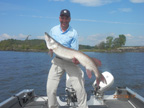|
|
Posts: 469
Location: Downers Grove, IL | Any suggestions on stainless props for my Emag and 60hp yammy? I noticed that my stock prop is turning over 6000 Rpms at full throttle. | |
| | |

Posts: 156
| My suggestion would be to take it VERY easy with pitch changes on a 60HP 4 stroke. I was told by numerous folk that it should be 200 rpm change per inch of pitch - including prop manufacturers.
My experience with 2 different 50hp 4stk motors - inch of pitch is worth about 400rpm change, NOT 200rpm as so often quoted. My theory is that the changes are bigger (as a percentage) with smaller motors because we are frequently working with 12, 13, 14 pitch props, as opposed to the 19, 20, etc. pitch props often used on larger motors. IE one inch of pitch is bigger percentage change going from say 13 to 14, than it is going from 19 to 20. Also suspect smaller motors are more sensitive to changes due to lower torque, etc.
If it were me I would think about adding one inch of pitch. I've had good luck with Solas aluminum props. | |
| | |

Posts: 3508
Location: Elk River, Minnesota | Hiya,
I would assume a 4 stroke as I don't believe yamaha made a 60 2 stroke that I am aware of.
The relative change is roughly 200 RPMs per inch of pitch and it is a relative amount as boat design, weight, etc all come into play when setting up your rig for your optimum performance. The change is fairly constant among all HP ranges due to smaller diameter props for smaller motors.
I believe that particular motor has a max of 6000 RPMs, so what would be good to know is what prop you have on it now, what are the max RPMs you are getting with that prop and under what load (gear, persons, gas, etc) you have on the boat as well.
There is a bunch you can do to deal with changes including a motor height change, prop design change, etc, but in your case with a 60hp motor, a steel prop may or may not help. The solas props are great props for the lower mid-range powerplants as the props are squeeze cast aluminum, which allows them to have more performance characteristics of steel with the cost of aluminum. The Alcup series (which I believe is the amita series now if memory serves me correctly) is cupped on the trailing edge giving it a better bite on the water than your standard white yamaha prop, which has very little (if any) trailing cup.
If you can get a baseline set of numbers, (speed, rpms and your prop size) we can go from there and see what possibilities can be had.
Steve | |
| | |
Posts: 38
| what size is your prop now I have a 60 hp yamaha on my 17 G3 tiller and was running a 10 3/8x 13 and turned 6000 rpm now I run the same pitch but a 11 1/4 and run about 5700 where I should be with a better hole shot, and gained 2-3 mph on topend, so it depends on size of prop also as well as pitch. I played around with different pitched props also and was around 200 rpm per inch on mine. I also tried the solas dident notice much dif than my stock yamaha prop. | |
| | |

Posts: 32944
Location: Rhinelander, Wisconsin | An Esox Mag is a padded FRP hull, not a deep V aluminum. BIG difference. Prop accordingly. | |
| | |

Posts: 3508
Location: Elk River, Minnesota | And I am sitting here contemplating HOW one could lose RPM in the designed prop, same construction materials in the same pitch and increase speed... The larger fins of a 11-1/4 might reduce prop slip a touch, but to lose 300 RPM's and gain 1 - 2 mph?
I'm no physics professor, but lets saythe original prop had a 15% slip. The new, larger diameter prop would have to have a slip factor of .06% NO stock aluminum prop, nor any aftermarket steel prop could attain a slip factor such as that on a multispecies/walleye/muskie, or even a top end bass boat could get to that point.
Now...lets say the original prop was 20% slip (Quite likely for a stock aluminum)...the larger prop would have to drop to 10%. With a stock yamaha aluminum... Very very doubtful to gain that much without other changes to the boat set-up. Can't say it couldn't happen, but I would say it is highly suspect.
Worrall would know with the Tuffy series as I believe he has helped design many of their model lines, so his suggestion to be mindful of the style of boat and propping accordingly is spot on. What happens on a deep V is quite different than a padded hull.
Steve | |
| |
|
 Stainless prop for Emag with 60hp Yammy
Stainless prop for Emag with 60hp Yammy Stainless prop for Emag with 60hp Yammy
Stainless prop for Emag with 60hp Yammy